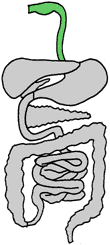 mouth
mouth
F r o m t h e
 S o , w h e r e
S o , w h e r e
s h o u l d w e
s t a r t ?
t o p , I
g u e s s . . . s o
l e t ' s c h e c k
o u t w h a t
h a p p e n s i n
t h e m o u t h !
m o u t h
![]() The process of digestion begins in the mouth where the size of the food is
mechanically reduced. While the food is being reduced, saliva is secreted
from the salivary glands and mixed with the food. This helps the food
particles to bind together and the food is chemically reduced. This is the
beginning of the digestion process.
The process of digestion begins in the mouth where the size of the food is
mechanically reduced. While the food is being reduced, saliva is secreted
from the salivary glands and mixed with the food. This helps the food
particles to bind together and the food is chemically reduced. This is the
beginning of the digestion process.
![]() The mouth uses the 32 teeth within to break down the food particles. They
are classified mainly by their shape and location. There are 3 types of
teeth in the mouth: incisors, cuspid, and molar. Incisors are
chisel-shaped, have sharp edges, and are used to bite off large pieces of
food. The cuspid is used to grasp or tear food. The molars
have flattened surfaces, and help in the grinding of food.
The mouth uses the 32 teeth within to break down the food particles. They
are classified mainly by their shape and location. There are 3 types of
teeth in the mouth: incisors, cuspid, and molar. Incisors are
chisel-shaped, have sharp edges, and are used to bite off large pieces of
food. The cuspid is used to grasp or tear food. The molars
have flattened surfaces, and help in the grinding of food.

![]() When the food is grinded it is mixed with saliva which dissolves some of
the food and acts as a lubricant. The human saliva contains a
starch-digesting enzyme that initiates the process of
enzymatic hydrolysis.
There is also an antimicrobal agent in the saliva, the
thiocyanite ion, together with a special enzyme that facilitates entry of
the ion into microbial cells. These substances help prevent harmful
microbes that constantly come along with the food from infecting our bodies.
The tongue then manipulates food during chewing and forms it into a mass, called
bolus. Before swallowing it pushes the bolus backward through the pharynx
and into the esophagus.
When the food is grinded it is mixed with saliva which dissolves some of
the food and acts as a lubricant. The human saliva contains a
starch-digesting enzyme that initiates the process of
enzymatic hydrolysis.
There is also an antimicrobal agent in the saliva, the
thiocyanite ion, together with a special enzyme that facilitates entry of
the ion into microbial cells. These substances help prevent harmful
microbes that constantly come along with the food from infecting our bodies.
The tongue then manipulates food during chewing and forms it into a mass, called
bolus. Before swallowing it pushes the bolus backward through the pharynx
and into the esophagus.
back to top